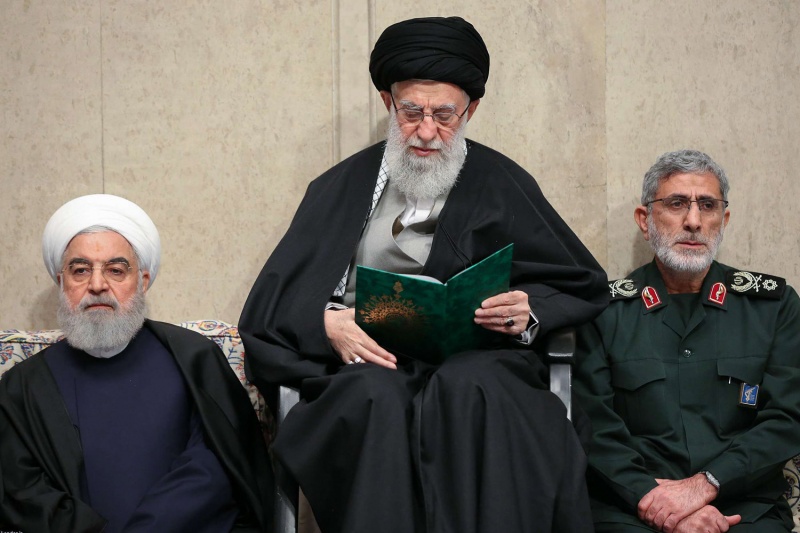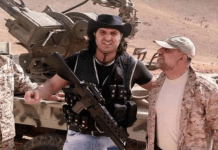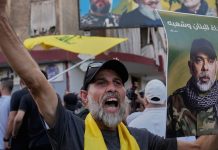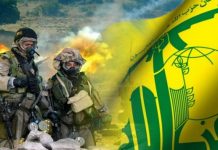Is the regime in Tehran in danger of falling?
Abdulrahman Al-Rashed/Arab News/January 14/2020
هل نظام المرشد في مهب الريح؟
عبد الرحمن الراشد/الشرق الأوسط/14 كانون الثاني/2020
التساؤلات حول تطورات الأحداث في إيران تلحّ في استكشاف مصير النظام، ما الذي يمكن أن يحدث؟
الهجوم الأميركي المباغت والمتكرر عليهم في العراق، وقتل أبرز قادتهم العسكريين، فعلياً هو أول امتحان حقيقي لصلابة النظام وقدراته منذ نهاية الحرب العراقية الإيرانية في أواخر الثمانينات.
عجزهم في طهران عن الرد المكافئ، وإسقاطهم الطائرة الأوكرانية، وعودة الاحتجاجات إلى شوارع طهران رافعة سقف مطالبها باستقالة المرشد الأعلى… كلها مصائب تراكمت على طهران. وهي ليست مجرد حظ سيئ مع مطلع العام ولا مصادفات، بل نتيجة طبيعية لنظام متهالك ومتغطرس، معاً.
فهذا الذي يبدو أمامنا أسداً من زئيره العالي ليس إلا نظاماً هرماً غير قادر على التكيف مع تبدلات الداخل ولا التأقلم مع محيطه والعالم. وسبق أن كتبت قبل الأزمة أن عدو دولة المرشد الأعلى ليست الولايات المتحدة ولا السعودية أو إسرائيل بل شعبها في الداخل الذي تتجاهله.
السؤال يتكرر وبإلحاح الآن: ما الاحتمالات مع الضغوط الداخلية والخارجية الهائلة عليه؟
أهون الاحتمالات، ولن يفعل، أن يسارع ويغيّر سياسته الداخلية والخارجية وينجو. الثاني، أن يتغير رأس النظام، فيستولي على السلطة أحد الجنرالات من الجيش أو «الحرس الثوري»، أمر مرهون بحجم التحركات في الشارع. وعليه أن يعيد إنتاج نفسه من جديد داخلياً وخارجياً. والاحتمال الثالث أن ينهار النظام تحت الضغوط الهائلة من الشارع ويقفز على السلطة من يتقدم الصفوف بدعم من المؤسسة العسكرية وينتهي نظام آية الله كما نعرفه. والاحتمال الرابع أن تستمر الاحتجاجات ويزيد القمع، وفي الأخير يسيطر النظام وسط بحر من الدماء كما فعل في سوريا، وسيقدم تنازلات كبيرة للخارج، وهو خيار قد لا يدوم طويلاً، لأن إيران بلد كبير ويعاني. والاحتمال الأخير أن ينهار النظام في لحظة وتدب الفوضى، وهذا خيار لا يتمناه أحد نظراً إلى خطورته على إيران والمنطقة. الحديث عن مصير النظام ليس نتيجة مقتل سليماني وما تلاه من كوارث على النظام، بل أمر متوقع منذ زمن، ولا شك أن الاتفاق النووي الذي تبنته الإدارة الأميركية السابقة منح قُبلة الحياة لطهران بعد أن كانت تعاني من العقوبات والعزلة. إلا أنها بدلاً من أن تصحح أخطاءها أمعنت فيها ورفعت مستوى مغامراتها في المنطقة وزاد قمعها للداخل وجاءت إدارة أميركية لتعيد العقوبات وتتحداه.
النظام تفكيره قديم ومؤسساته الخدمية متآكلة، ولا يزال يمارس سياسته بنفس الأساليب والأدوات البائسة؛ القتل والخطف والتنظيمات العميلة وآيديولوجيا التطرف الطائفي. لهذا ليس غريباً أن يفقد السيطرة؛ يُسقط طائرة بالخطأ، ويخسر أهم قادته العسكريين، وتنهار قدراته التموينية الضرورية لحياة الناس، ويعجز عن بيع بتروله في السوق العالمية! ورغم ذلك تريد أن تواجه قوة ضخمة كالولايات المتحدة، والسيطرة على أربع دول عربية. سياسة النظام العدائية الشرسة تديرها ثلة من الكهول في طهران، بكفاءات إدارية واقتصادية محدودة. أما قدرته على استخدام الصواريخ الباليستية، وطائرات الدرونز، وشنه بعض الهجمات المتطورة مثل هجومه على «أرامكو»، فإن معظمها يعود لدعم حلفائه له مثل كوريا الشمالية، وأخرى معادية للقطب الأميركي. النظام منذ وصوله للحكم لم يبنِ دولة حديثة وصناعية بل بنى آلة عسكرية ودعائية كبيرة توهم شعبه والخارج أنه قادر على الاستقلال والإنتاج والحرب. لديه منظومة عسكرية ضخمة، من قوات نظامية، وميليشياوية واحتياط، ربما تعطيه قوة هائلة، مع هذا ها هو لا يستطيع تدبّر أمره حتى في تطوير مصافي النفط التي ورثها من عهد الشاه مع ما ورث.
Is the regime in Tehran in danger of falling?
Abdulrahman Al-Rashed/Arab News/January 14/2020
The questions raised by the latest developments in Iran largely focus on what may happen next, and the ultimate fate of the regime.
The surprise and repeated attacks on Iran’s interests in Iraq, and the killing of one of its most prominent military commanders, Quds Force commander Qassem Soleimani, constitute the first real test of the regime’s strength and capabilities since the end of the Iran-Iraq War of the 1980s.
Its inability to adequately retaliate, together with the shooting down of a Ukrainian passenger plane by Iranian forces and the return of protesters to the streets of Tehran demanding the resignation of Supreme Leader Ali Khamenei, have raised the stakes and now represent an accumulation of calamities for Tehran.
These events are not simply the result of bad luck at the beginning of a new year, nor are they mere coincidences, but rather natural consequences for a regime that is broken and arrogant.
This regime, which presents to the world the appearance of a roaring lion, is in fact old, tired, outdated and incapable of coping with changes in the country, the region and the world. Before the current crisis, I wrote that the true enemy of the supreme leader’s nation is not the US, Saudi Arabia or Israel, but the people it is ignoring within Iran’s own borders.
The big recurrent question now is what options does Iran have in light of the enormous and growing internal and external pressures? There are five main possibilities. The first, and easiest, for the supreme leader — but one he will not adopt — would be to quickly change his internal and external policies so that he can survive.
A second, depending on how the protests progress, may be the removal of the head of the regime, with an army chief or Islamic Revolutionary Guard Corps general seizing power and implementing changes internally and externally.
This regime, which presents to the world the appearance of a roaring lion, is in fact old, tired, outdated and incapable of coping with changes in the country, the region and the world.
A third possibility is the collapse of the regime under huge pressure from the protesters, with one of the leaders of the protest movement taking over with the support of the military establishment, marking the end of the ayatollah’s regime.
The fourth is that the protests continue and violent repression increases, with the regime managing to cling to power in a pool of blood; as happened in Syria. This would force it to make great concessions abroad. However, this outcome could not endure because Iran is a big country in deep trouble.
The fifth possibility is a sudden, full collapse of the regime, causing widespread chaos. This is desired by no one, given the danger it would pose not only to Iran, but also to the entire region.
The speculation about whether the Iranian regime can survive is not simply the result of the killing of Soleimani, and the subsequent disasters it is facing; but this is something that has been expected for a long time. And despite the 2015 nuclear agreement, endorsed by the administration of former US President Barack Obama, which no doubt provided a lifeline to Tehran when it was suffering from the effects of sanctions and international exclusion.
But instead of correcting its mistakes, the Tehran regime committed even more of them, raising the level of its disruptive influence in the region, and increasing its internal oppression. This led US President Donald Trump’s administration to withdraw from the nuclear deal, reinstate sanctions and challenge Tehran.
The regime’s thinking is old-fashioned and its service institutions have eroded. It continues to pursue its agenda using the same miserable methods and tools, like: Murders, kidnappings, proxy organizations and extremist sectarian ideology. Thus, it is not a surprise that the regime has lost control, shot down a plane by mistake and lost one of its military commanders. Moreover, its developmental capacity, which is necessary to ensure the quality of its people’s lives, has collapsed, and it is now unable to sell its oil on the global market. Despite all this, the regime still wants to challenge a huge global power such as the US, and control four Arab states.
In fact, the Tehran regime’s fierce and hostile policies are managed and dictated by a bunch of old men with limited administrative and economic expertise. Its ability to use ballistic missiles and drones to carry out attacks, such as those used on Saudi Aramco facilities last year, is mostly the fruit of the support it receives from allies such as North Korea, and others hostile to the US.
Since coming to power in 1979, the regime has failed to build a modern, industrial state. Instead, it has created a huge military and propaganda machine that attempts to delude its own people and those in other countries about its ability to remain independent, and to start and fight wars.
True, it possesses a huge military system, including formal forces, militias and reserves, which should be able to provide Tehran with immense power; but it is incapable of managing its own affairs, not even the development of the oil refineries it inherited from the shah’s regime.
• Abdulrahman Al-Rashed is a veteran columnist. He is the former general manager of Al Arabiya news channel, and former editor in chief of Asharq Al-Awsat. Twitter: @aalrashed






















